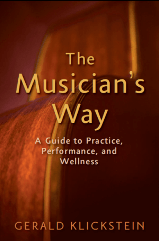“I suppose that when I play in public it looks easy, but before I ever came on the concert stage I worked very hard. And I do yet – but always putting the two things together, mental work and physical work.”
-Jascha Heifetz, violinist (1901-1987)
The Musician’s Way, p. 42
Soulful music making springs from a complex interplay of mental, physical, and emotional actions.
Despite the complexities, when we assimilate a piece through deep practice, we can perform in ways that not only look easy, but actually are easy for us to execute.
A combination of mental and physical practice can equip us to achieve such mastery.
This article sums up some ways in which instrumentalists can combine mental and physical practice techniques. See Part I of The Musician’s Way for details along with applications of these concepts for singers.
In Solo Practice
- When learning new material, before executing passages on your instrument, mentally image each passage at a slow tempo so that you internalize your interpretative and technical plans before playing. Expressively vocalize as you image; you might mime the playing motions, too.
- Make your imaginary playing as realistic as you can: hear the music in your mind, register tactile and movement sensations, connect with the expressive shape of phrases.
- If you encounter phrases with tricky rhythms or pitches, isolate the thorny bits, and then precisely sing them before imaging again so that you form an accurate sound picture.
- As you repeat passages – whether mentally or physically – be playful, and bring out the expressive content of every musical gesture. In that way, you form emotionally rich, artistic habits, and your interpretations continually grow. In contrast, musicians who repeat mechanically in practice rooms ingrain emotionless habits, which manifest in dull, unmusical performances.
- When memorizing, hold off playing material from memory until you can readily image it. For instance, you might image a section of a piece from memory, review any unclear passages using the score, and then image from memory again. After that, playing it from memory should feel easy.
- Be sure to feel ahead when both imaging and executing.
- When increasing tempo, step up incrementally using a metronome, mentally imaging passages at a new tempo before playing them. First, ensure that you can execute with complete ease at your initial tempo, leading your playing from within.
During Small Ensemble Practice
- If a colleague suggests a change of phrasing or tempo, before playing a passage anew, mentally hear and feel yourself executing it in the new way. Then, as you play together, image ahead, and commit to the expressive character of the revisions.
- If you fumble a passage, stop your group, and briefly image the problematic bit to clarify it before you collectively repeat.
- During rehearsal breaks, when you’re physically resting but still mentally sharp, you might image sections that you’ll tackle when group practice resumes.
Between Practice Sessions
- When riding public transport, mentally review chunks of music that you’ll work on in solo or group practice.
- As you mentally image an ensemble part, aim to hear the inclusive sound of the group.
- During periods of downtime throughout a day, even brief ones, mentally review portions of music that you’re learning or memorizing.
- Listen to diverse recordings and watch performance videos of music you’re mastering to gather fresh interpretive ideas as well as novel solutions to technical challenges.
* * *
By deliberately merging mental and physical practice in these and other ways, we assimilate compositions so fully that we can perform without fear.
The thoroughness of our learning then sets us free to present concerts that transport us and our listeners to loftier planes.
The Musician’s Way articulates an inclusive path to musical excellence. Read reviews.
Related posts
7 Deep-Practice Strategies
Beautiful Repetition
Mental Imaging
The Perils of Mindless Repetition
© 2022 Gerald Klickstein


